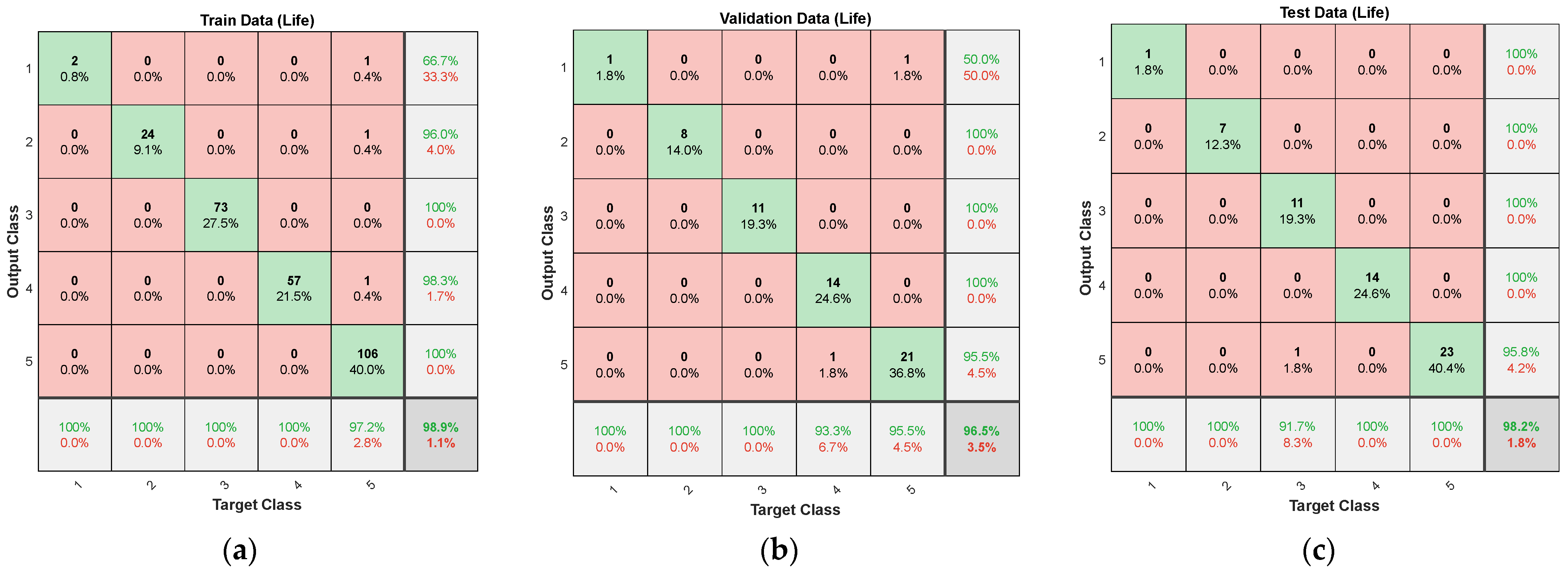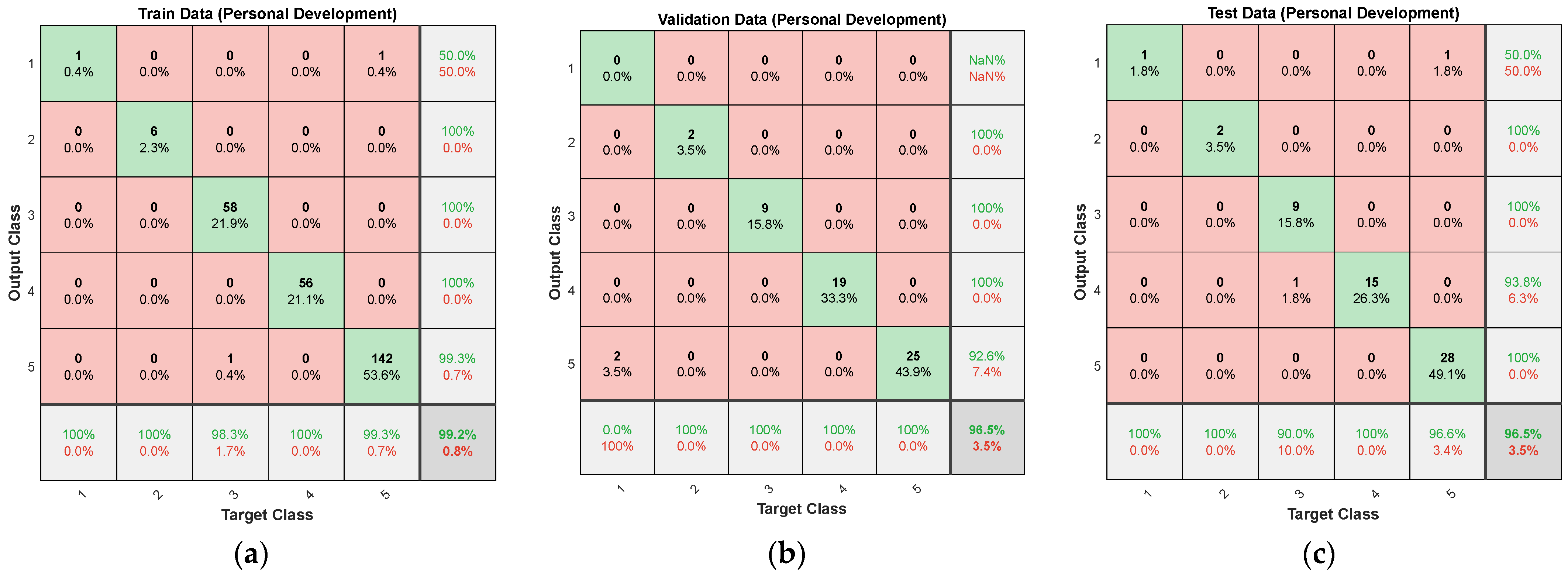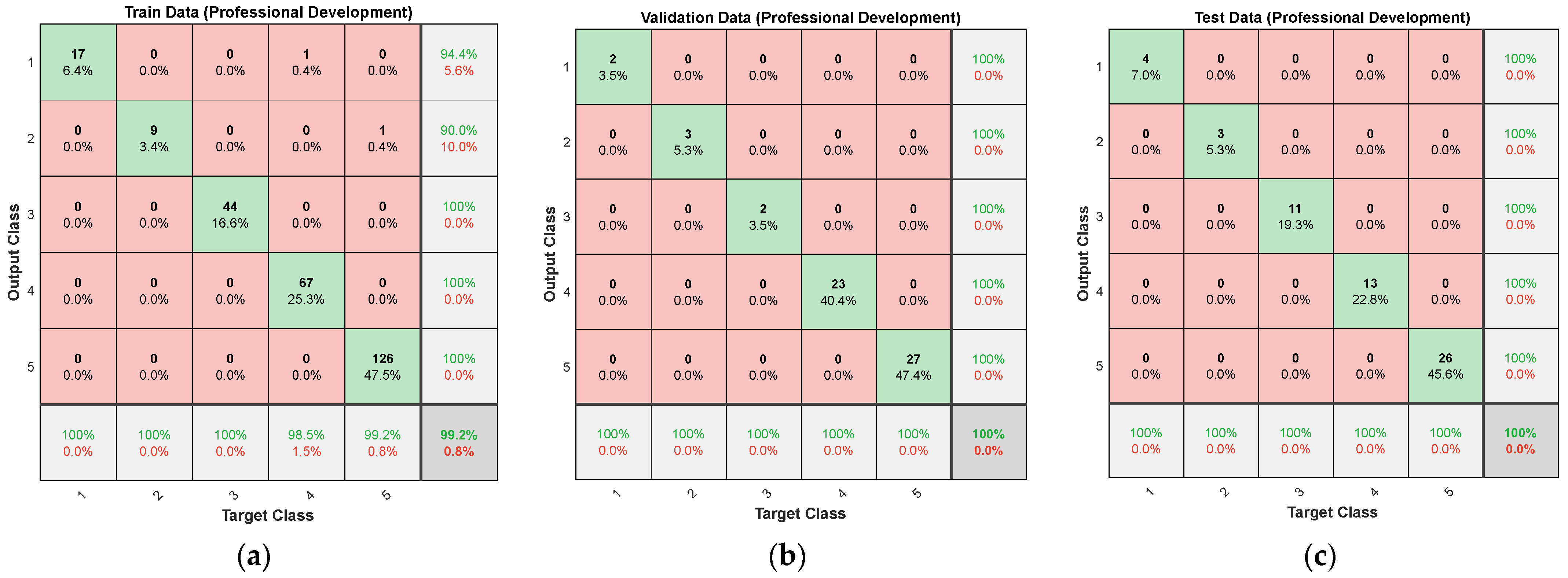Proposing a Method Based on Artificial Neural Network for Predicting Alignment between the Saudi Nursing Workforce and the Gig Framework
Abstract
:1. Introduction
2. Data Acquisition
MLP Neural Network
3. Result and Discussion
4. Conclusions
Author Contributions
Funding
Institutional Review Board Statement
Informed Consent Statement
Data Availability Statement
Conflicts of Interest
Appendix A
| Questions | Numerical Equivalents |
|---|---|
| Gender: | Male = 1 Female = 2 |
| Age: | 18–20 = 1 21–30 = 2 31–40 = 3 41–50 = 4 51–60 = 5 >60 = 6 |
| Education: | High school = 1, Diploma = 2 Bachelor’s degree = 3 Master’s degree = 4 Ph.D. = 5 Others = 6 |
| Role: | Staff nurse = 1 Nurse manager = 2 |
| Experience: | <3 years = 1 3–6 years = 2 7–9 years = 3 10–12 years = 4 >12 years = 5 |
| Nationality: | Saudi = 1 Non-Saudi = 2 |
| Please mark off the items below that have an impact on Saudi Arabia’s nursing industry. |
|
References
- Kapoor, A. The Challenge with Gig Economy. Available online: https://economictimes.indiatimes.com/jobs/the-challenge-with-Gig-economy/articleshow/85031089.cms (accessed on 20 January 2022).
- Healy, J.; Nicholson, D.; Pekarek, A. Should we take the Gig economy seriously? Lab Ind. J. Soc. Econ. Relat. Work 2017, 27, 232–248. [Google Scholar] [CrossRef]
- Woodcock, J.; Graham, M. The Gig Economy. Available online: http://acdc2007.free.fr/woodcock2020.pdf (accessed on 20 January 2022).
- Wishart, R.; Cornick, P. The Characteristics of Those in the Gig Economy; Department for Business, Energy and Industrial Strategy: London, UK, 2018. Available online: https://www.gov.uk/government/publications/Gig-economy-research (accessed on 20 January 2022).
- ILR School. How Many Gig Workers Are There? Available online: https://www.gigeconomydata.org/basics/how-many-Gig-workers-are-there (accessed on 20 January 2022).
- World Economic Forum. What Is the Gig Economy and What’s the Deal for Gig Workers? Available online: https://www.weforum.org/agenda/2021/05/what-Gig-economy-workers/ (accessed on 20 January 2022).
- Broda, K. Gig Economy—The Economic Backbone of the Future? Available online: https://brodmin.com/case-studies/Gig-economy-case-study/ (accessed on 20 January 2022).
- Kumar, H. How India is Taking over the Gig Economy on a Global Stage. Available online: https://www.financialexpress.com/brandwagon/how-india-is-taking-over-the-Gig-economy-on-a-global-stage/2368291/ (accessed on 20 January 2022).
- Western Governers University. The Pros and Cons of the Gig Economy. Available online: https://www.wgu.edu/blog/pros-and-cons-Gig-economy1808.html#close (accessed on 21 January 2022).
- Alluhidan, M.; Tashkandi, N.; Alblowi, F.; Omer, T.; Alghaith, T.; Alghodaier, H.; Alazemi, N.; Tulenko, K.; Herbst, C.H.; Hamza, M.M.; et al. Challenges and policy opportunities in nursing in Saudi Arabia. Hum. Resour. Health 2020, 18, 98. [Google Scholar] [CrossRef] [PubMed]
- United Nations. World Population by 2300; United Nations: New York, NY, USA, 2004. [Google Scholar]
- OECD. Health at a Glance 2017: OECD Indicators; OECD Publishing: Paris, France, 2017. [Google Scholar]
- Aboshaiqah, A. Strategies to address the nursing shortage in Saudi Arabia. Int. Nurs. Rev. 2016, 23, 499–506. [Google Scholar] [CrossRef] [PubMed]
- Miller-Rosser, K.; Chapman, Y.; Francis, K. Historical, cultural, and contemporary influences on the status of women in nursing in Saudi Arabia. Online J. Issues Nurs. 2006, 11, 1–15. [Google Scholar] [CrossRef]
- Alboliteeh, M.; Magarey, J.; Wiechula, R. The profile of Saudi nursing workforce: A cross-sectional study. Nurs. Res. Pract. 2017, 2017, 1710686. [Google Scholar] [CrossRef]
- Elmorshedy, H.; AlAmrani, A.; Hassan, M.H.A.; Fayed, A.; Albrecht, S.A. Contemporary public image of the nursing profession in Saudi Arabia. BMC Nurs. 2020, 19, 47. [Google Scholar] [CrossRef]
- Alotaibi, J.; Paliadelis, P.S.; Valenzuela, F. Factors that affect the job satisfaction of Saudi Arabian nurses. J. Nurs. Manag. 2016, 24, 275–282. [Google Scholar] [CrossRef]
- Almalki, M.; Fitzgerald, G.; Clark, M. Health care system in Saudi Arabia: An overview. East. Mediterr. Health J. 2011, 17, 784–793. [Google Scholar] [CrossRef]
- Van Rooyen, D.; Telford-Smith, C.D.; Stumpher, J. Nursing in Saudi Arabia: Reflections on the experiences of South African nurses. Health SA Gesondheid 2010, 15, 1–9. [Google Scholar] [CrossRef]
- Huxley. Rise of Contract Recruitment in Saudi Arabia. Available online: https://www.huxley.com/en-ae/blog/2021/04/rise-of-contract-recruitment-in-saudi-arabia/?__cf_chl_jschl_tk__=QqiFVaPAltf61q9OUu0O28nL.tB5bPZql6Z4BqmO6C8-1642660817-0-gaNycGzNCKU (accessed on 21 January 2022).
- Alanzi, T. Prospects of integrating Gig economy in the Saudi Arabian health-care system from the perspectives of health-care decision-makers and practitioners. J. Healthc. Lead. 2021, 13, 255–265. [Google Scholar] [CrossRef]
- Alanzi, T.M. Gig health vs eHealth: Future prospects in Saudi Arabian health-care system. J. Multidiscip. Healthc. 2021, 14, 1945–1953. [Google Scholar] [CrossRef] [PubMed]
- Al Kuwaiti, A.; Al Muhanna, F.A.; Al Amri, S. Implementation of digital health technology at Academic medical centers in Saudi Arabia. Oman Med. J. 2018, 33, 367–373. [Google Scholar] [CrossRef] [PubMed]
- Alanezi, F.; Alanzi, T. A Gig mHealth Economy Framework: Scoping Review of Internet Publications. JMIR Mhealth Uhealth 2020, 8, e14213. [Google Scholar]
- Naghieh, A. Gig economy and the transformation of professional boundaries in healthcare. In Conflict and Shifting Boundaries in the Gig Economy: An Interdisciplinary Analysis; Emerald Publishing: Bingley, UK, 2020; pp. 129–138. [Google Scholar]
- Alperin, P. Physicians and the Gig Economy. 2020. Available online: https://www.physicianleaders.org/news/physicians-and-the-Gig-economy (accessed on 10 March 2022).
- Reem, A.D. Investigating the feasibility of applying the GEF in the nursing profession towards the Saudi Arabian vision 2030. Inform. Med. Unlocked 2022, 30, 100921. [Google Scholar]
- Allon, G.; Cohen, M.C.; Moon, K.; Sinchaisri, W. Managing Multihoming Workers in the Gig Economy (). Available online: https://ssrn.com/abstract=4502968 (accessed on 6 July 2023). [CrossRef]
- Dzulfiqar, A.A.; Oktofa, Y.S. Factors Affecting Investment Decisions in the Gig Economy in the City of Bandung. Int. J. Curr. Sci. Res. Rev. 2023, 6, 4810–4821. [Google Scholar]
- van Slageren, J.; Herrmann, A.M.; Frenken, K. Is the online gig economy beyond national reach? A European analysis. Socio-Econ. Rev. 2023, 21, 1795–1821. [Google Scholar] [CrossRef]
- Behl, A.; Rajagopal, K.; Sheorey, P.; Mahendra, A. Barriers to entry of gig workers in the gig platforms: Exploring the dark side of the gig economy. Aslib J. Inf. Manag. 2022, 74, 818–839. [Google Scholar] [CrossRef]
- Vučeković, M.; Avlijaš, G.; Marković, M.R.; Radulović, D.; Dragojević, A.; Marković, D. The relationship between working in the “gig” economy and perceived subjective well-being in Western Balkan countries. Front. Psychol. 2023, 14, 1180532. [Google Scholar] [CrossRef]
- Zheng, Q.; Yang, W. The Characteristics of the Gig Economy; Cambridge Open Engage: Cambridge, UK, 2020. [Google Scholar] [CrossRef]
- Taber, K.S. The use of cronbach’s alpha when developing and reporting research instruments in science education. Res. Sci. Educ. 2018, 48, 1273–1296. [Google Scholar] [CrossRef]
- Cochran, W.G. Sampling Techniques, 2nd ed.; John Wiley and Sons, Inc.: New York, NY, USA, 1963. [Google Scholar]
- Basahel, A.; Sattari, M.A.; Taylan, O.; Nazemi, E. Application of Feature Extraction and Artificial Intelligence Techniques for Increasing the Accuracy of X-ray Radiation Based Two Phase Flow Meter. Mathematics 2021, 9, 1227. [Google Scholar] [CrossRef]
- Taylan, O.; Sattari, M.A.; Elhachfi Essoussi, I.; Nazemi, E. Frequency Domain Feature Extraction Investigation to Increase the Accuracy of an Intelligent Nondestructive System for Volume Fraction and Regime Determination of Gas-Water-Oil Three-Phase Flows. Mathematics 2021, 9, 2091. [Google Scholar]
- Roshani, G.H.; Ali, P.J.M.; Mohammed, S.; Hanus, R.; Abdulkareem, L.; Alanezi, A.A.; Sattari, M.A.; Amiri, S.; Nazemi, E.; Eftekhari-Zadeh, E.; et al. Simulation Study of Utilizing X-ray Tube in Monitoring Systems of Liquid Petroleum Products. Processes 2021, 9, 828. [Google Scholar] [CrossRef]
- Taylor, J.G. Neural Networks and Their Applications; John Wiley & Sons Ltd.: Brighton, UK, 1996. [Google Scholar]
- Gallant, A.R.; White, H. On learning the derivatives of an unknown mapping with multilayer feedforward networks. Neural Netw. 1992, 5, e129–e138. [Google Scholar] [CrossRef]






Disclaimer/Publisher’s Note: The statements, opinions and data contained in all publications are solely those of the individual author(s) and contributor(s) and not of MDPI and/or the editor(s). MDPI and/or the editor(s) disclaim responsibility for any injury to people or property resulting from any ideas, methods, instructions or products referred to in the content. |
© 2023 by the authors. Licensee MDPI, Basel, Switzerland. This article is an open access article distributed under the terms and conditions of the Creative Commons Attribution (CC BY) license (https://creativecommons.org/licenses/by/4.0/).
Share and Cite
AL-Dossary, R.; Mayet, A.M.; Bhutto, J.K.; Shukla, N.K.; Nazemi, E.; Qaisi, R.M.A. Proposing a Method Based on Artificial Neural Network for Predicting Alignment between the Saudi Nursing Workforce and the Gig Framework. Sustainability 2023, 15, 12728. https://doi.org/10.3390/su151712728
AL-Dossary R, Mayet AM, Bhutto JK, Shukla NK, Nazemi E, Qaisi RMA. Proposing a Method Based on Artificial Neural Network for Predicting Alignment between the Saudi Nursing Workforce and the Gig Framework. Sustainability. 2023; 15(17):12728. https://doi.org/10.3390/su151712728
Chicago/Turabian StyleAL-Dossary, Reem, Abdulilah Mohammad Mayet, Javed Khan Bhutto, Neeraj Kumar Shukla, Ehsan Nazemi, and Ramy Mohammed Aiesh Qaisi. 2023. "Proposing a Method Based on Artificial Neural Network for Predicting Alignment between the Saudi Nursing Workforce and the Gig Framework" Sustainability 15, no. 17: 12728. https://doi.org/10.3390/su151712728
APA StyleAL-Dossary, R., Mayet, A. M., Bhutto, J. K., Shukla, N. K., Nazemi, E., & Qaisi, R. M. A. (2023). Proposing a Method Based on Artificial Neural Network for Predicting Alignment between the Saudi Nursing Workforce and the Gig Framework. Sustainability, 15(17), 12728. https://doi.org/10.3390/su151712728






